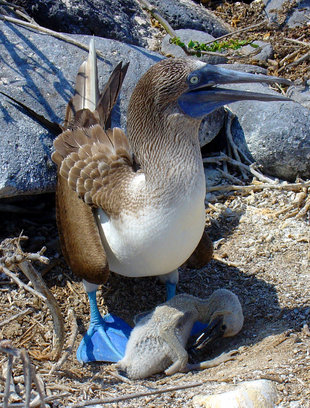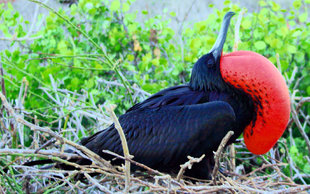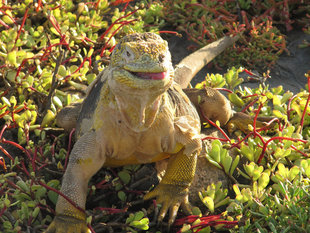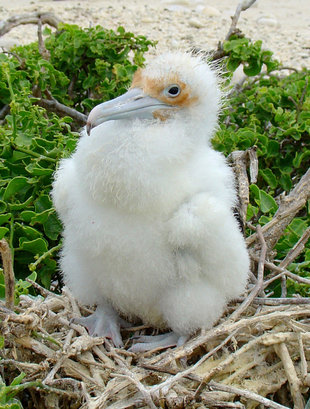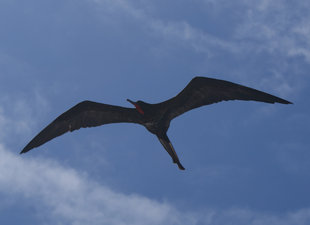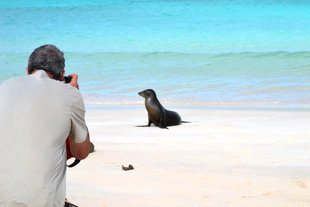Area Size: 0.73 Km²
Maximum Altitude: 30 meters / 98 feet
Island Highlights: Blue-Footed Booby, Swallow Tailed Gull, Frigatebird, Galapagos Land Iguana, Galapagos Sea Lion
Introduction
North Seymour is a small island located just north of Baltra across a narrow channel in the centre of the Galapagos archipelago. The name of the island derived from English nobleman, Lord Hugh Seymour.
The island has a wealth of birdlife, many of which can be seen up close, consequently there are some fantastic photographic opportunities to be sort on North Seymour.
Due to the virtual flatness of the island its relatively small size, North Seymour is perfect for leisurely hiking, which is ideal when there are so many opportunities to take photos and observe the local wildlife. It is also a great island for swimming, snorkelling and diving, with a wealth of marine life to discover and explore.
Many of our Wildlife Yacht Safaris will take you to North Seymour where you can be taken on land to explore on foot.
Divers can enjoy North Seymour on some of our liveaboard trips, as well as regular day trips to the island for those divers who prefer to be land based. Those based on a liveaboard are likely to dive both along the east coast of North Seymour and nearby Mosquera Island. Mosquera is covered in a beautiful yellow sand beach which is home to many sea lions. Although you will not be able to land on Mosquera, you will be able to see families of sea lions and spot how a dominant male maintains control of his harem of females.
Dive sites for day trip divers will depend upon conditions on the day, but in between dives you are likely to take lunch close to a sea cliff covered in seabirds, and a small rock archway where you can get into the water to snorkel and swim with sea lions. Click Here for further information about the dive sites of Galapagos.
Wildlife
North Seymour is an island rich in life, with a multitude of fascinating species to look out for.
The one and only visitor site on North Seymour is that of a 2 km circular nature trail, located on the south-western side of the island. The trail leads inland, then on to explore the rocky coastline, with wildlife spotting opportunities abundant throughout. Blue-footed boobies can be found nesting on either side of the trail and are often seen in their pairs performing their courtship dance.
The relationship between blue-footed boobies and frigate birds is an interesting one. Blue footed boobies are well known for being excellent fishers, generally hunting in flocks. In contrast, frigate birds are somewhat lazy when it comes to fishing, so instead they dive-bomb the blue-footed boobies, forcing them to drop their catch, which they then elegantly retrieve in acrobatic fashion.
Further along the trail, a narrow strip of sand can be found inland, where flocks of sea birds can be spotted in their masses, including swallow-tailed gulls. The trail eventually leads inland to the largest nesting site in the Galapagos of the Magnificent Frigate Bird. These birds are a joy to witness with their impressive 5 foot wingspan and large scarlet gular pouches, which they inflate when attempting to attract a mate. They are frequently seen perched on low branches, guarding their nests. Frigate birds are also likely to hover above your yacht whilst it is at anchor close to North Seymour. They may come to within a couple of metres of you which is close enough to see the red gulas of the males. Nazca boobys also often fly past as well as other birds such as swifts.
Conservation Issues
The land iguanas which inhabit North Seymour island derive from the iguanas which William Randolph Hearst brought from Baltra Island in the 1930s. This inadvertently proved to be a very lucky move, as the subsequent establishment of the military base resulted in the extinction of land iguanas on their native island of Baltra. In a bid to repopulate Baltra with its endemic land iguanas, a pair of North Seymour land iguanas was taken to the breeding centre in Santa Cruz, where a breeding plan implemented. In 1991, land iguanas were once again reintroduced back onto Baltra, where they have since increased in numbers and can often be seen in the areas surrounding the airport.
Geology
The island of North Seymour was formed following the uplift of submarine lava formation and as such is fairly flat in gradient, with cliffs only rising to a few metres above the shoreline. These cliffs are popular resting areas for swallow-tailed gulls which can often we seen perched on the cliff edge. The island is carpeted by dense vegetation, including prickly pear cacti and salt bushes. Palo santo trees can usually be seen at the landing site, but are often bare, waiting for rain to bring them into bloom.
North Seymour

